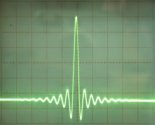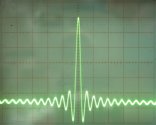|
|
|
|
Article
|
|
Listening digital filter - June 2004
|
Last revision on July 2007
|
|
|
Listening digital filter - June 2004, by Eric Juaneda
It’s very difficult to compare different equipments and listening audio
quality of the digital filter. The audio quality is the result of all the numeric and
analog stages. The only way would to have different digitals filters on the same device.
The DVD Philips™ DVP 720SA have a very interesting function. The user manual
mentions the ability to change the oversampling rate. It has ability to directly
send the data sample to the D/A converter, or interpolate by 2x or 4x.
|
 Philips DVP 720SA
Philips DVP 720SA
|
 Dirac impulse response in «Inactive» mode
Dirac impulse response in «Inactive» mode
|
 Dirac impulse response in «88.2 kHz (x2)» mode
Dirac impulse response in «88.2 kHz (x2)» mode
|
|
Technical description - Analysis of the analog output.
see also dirac impluse response
The DVD 720SA use an AKM™ AK4382 and a Crystal™ CS4360, delta-sigma D/A converters.
The AKM7382 is used for stereo output and CS4360 for multi channels outputs. AK4382 accepts 16 kHz
to 192 kHz/200 kHz input frequency. In « Inactive » mode, the digital audio signal is directly send to
the AK4382 (fe=44.1 kHz). In « 88.2 kHz (x2) » and « 176.4 kHz (x4) » mode, signal is first interpolated
by a specific digital filter and sends to 88.1 kHz or 176.4 kHz to the D/A converter. Specific oversampling
affect audio signal by adding interpolated samples calculated by a digital filter. The number of TAP filter
is greater than the number of TAP filter used internally by the AKM4382. The number of undulation increase.
Listening test
Subjective listening in « 176.4kHz (x4) » or « 88.2kHz (x2) » mode:
- Very depth sonic imaging (directly proportional with the number of TAP filter)
- Bass frequencies seem always be the same (rounded and pleasant)
- Singer’s voice loose personality
- Confuse sonic message when general audio level increase
Subjective listening in « Inactive » mode:
- Each music instrument has its own personality
- Sound more natural, less metallic
- Bass frequencies, more important or totally away
- Very high imaging stability
- Sonic message don’t be confuse when general audio level increase
The best sounding occur in « Inactive » mode. The sound is more natural, each music instrument keep it’s place whatever sonic level. It’s easy to follow one instrument or voice over the over. Digital filter seem to be more important than D/A converter’s resolution.
About digital filter
The difference between a high end digital interpolation filter (DIF) and a basic one is the number of bit used to compute the interpolated sample (16, 20, 24, 32bit) and the number of TAP filter. If a high number of bit computing increase sonic performance, high number of TAP filter decreases it.
Examining DIF
To compute 8x oversampling, the Burr-Brown™ DF1700 cascade 3 FIR filters.

DF1, DF2 and DF3 are 2x oversampling FIR digital filters.
Most important FIR filter is the 153 tap filter. You can draw Dirac impulse response by drawing 76 undulations before and 76 undulations after impulse.
Oher DIF :
NPC™ SM5847 : 169 taps, 29 taps, 17 taps.
NPC™ SM5847 : 121 taps, 21 taps, 13 taps.
Philips™ SAA7220 : 30 taps, 30 taps.
A high number of TAP filter is needed to obtain the 0.00005% passband ripple. This is not compatible with good audio performance. Fortunately, many DIF include a slow roll off function (SRO). This function reduce (not sufficiently) the number of tap filter. The low cost delta-sigma D/A converter use small calculator with less tap filter. (by design, this low cost converter sound digitally better, unfortunately, the analog section is poor.)
There is two way to have a good sonic performance, don’t use digital filter, or built it your own!
see also "Non-oversampling Digital filter-less DAC Concept" by Ryohei Kusunoki.
Extending listening test
After this experience, I take much digital audio equipment and look for the
Dirac impulse response. It wouldn’t be difficult to find another low TAP digital filter.
I find in my computer a very good impulse response! (DELL™ GX260)*
Listening test confirm sounding family. If your computer is equipped with an Analog Device™ SoundMax,
or Sigmatel™ STAC97 audio card, you could try listening test.
see also PC card dirac impluse response
(*) Dell™ GX 260 powered by Microsoft™ Windows XP and Windows Media Player 9
Sound card : Analog Device™ SoundMax integrated digital audio.
AD1981A - 20bits DAC, 18bits ADC.
Conclusion
Subjective result depends on recording.
With a conventional digital filter (high number of TAP filter) the audio quality is constant:
not realistic, confuse, not really aggressive or smooth, always pleasant.
With light digital filter (few number of TAP filter) result is very different.
In some case it seems to be another record!
Sometime, global performance is just different (not better or worse),
with other record global performance is better, with other record global performance is awful.
With light digital filter voice and instruments are more realistic more coherent.
Careful: If you try this listening test, careful to the conclusion. When you listen PC audio card,
you listen at first a lows cost, low quality D/A converter. Even if digital filter carry good sounding,
analog performance is poor and bad, general sounding is bad too. I speak about sound family;
my PC doesn’t become my system reference.
|
|



